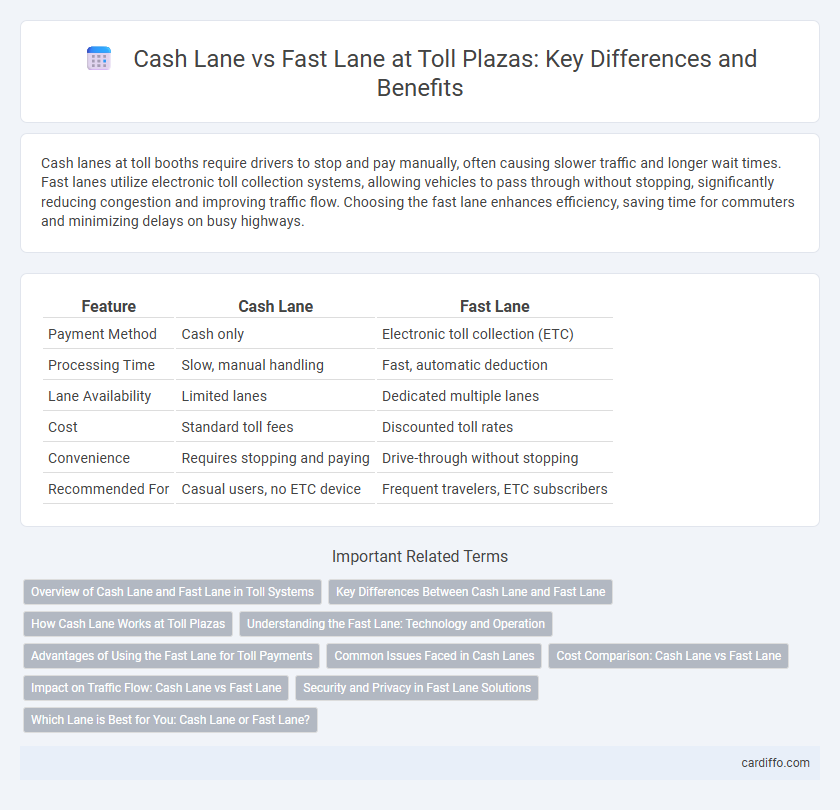Cash lanes at toll booths require drivers to stop and pay manually, often causing slower traffic and longer wait times. Fast lanes utilize electronic toll collection systems, allowing vehicles to pass through without stopping, significantly reducing congestion and improving traffic flow. Choosing the fast lane enhances efficiency, saving time for commuters and minimizing delays on busy highways.
Table of Comparison
| Feature | Cash Lane | Fast Lane |
|---|---|---|
| Payment Method | Cash only | Electronic toll collection (ETC) |
| Processing Time | Slow, manual handling | Fast, automatic deduction |
| Lane Availability | Limited lanes | Dedicated multiple lanes |
| Cost | Standard toll fees | Discounted toll rates |
| Convenience | Requires stopping and paying | Drive-through without stopping |
| Recommended For | Casual users, no ETC device | Frequent travelers, ETC subscribers |
Overview of Cash Lane and Fast Lane in Toll Systems
Cash lanes in toll systems require vehicles to stop and make manual payments either through cash or card, resulting in slower processing times and potential traffic congestion. Fast lanes utilize electronic toll collection (ETC) technology with transponders or license plate recognition, enabling seamless, high-speed passage without stopping. This distinction significantly impacts traffic flow efficiency and user convenience on toll roads.
Key Differences Between Cash Lane and Fast Lane
Cash lanes require drivers to stop and pay tolls using cash, resulting in slower processing times and potential congestion during peak hours. Fast lanes utilize electronic toll collection systems like RFID tags or transponders, enabling seamless passage without stopping and significantly reducing traffic delays. The key differences lie in payment methods, speed of transaction, and overall efficiency in managing traffic flow at toll plazas.
How Cash Lane Works at Toll Plazas
Cash lanes at toll plazas require drivers to stop and pay toll fees using cash or coins, involving manual transactions handled by toll booth operators. This process typically results in longer wait times due to the time taken for payment and issuing receipts. Cash lanes are essential for drivers without electronic toll tags, but slower compared to fast lanes equipped with electronic toll collection systems.
Understanding the Fast Lane: Technology and Operation
The Fast Lane employs electronic toll collection systems, utilizing RFID transponders or Automatic Number Plate Recognition (ANPR) cameras to enable seamless vehicle passage without stopping. This technology minimizes congestion and reduces travel time by automatically debiting toll fees from linked accounts in real-time. Compared to the Cash Lane, which requires physical payment and causes delays, the Fast Lane optimizes traffic flow through advanced software and sensor integration.
Advantages of Using the Fast Lane for Toll Payments
Fast Lane toll payments significantly reduce wait times by enabling seamless electronic transactions without stopping at toll booths, improving traffic flow and reducing congestion. Using Fast Lane systems minimizes fuel consumption and vehicle emissions by allowing continuous movement, contributing to environmental benefits. Enhanced convenience through automated billing and real-time payment processing eliminates the need for cash handling, streamlining the toll payment experience for frequent travelers.
Common Issues Faced in Cash Lanes
Cash lanes at toll booths often experience longer wait times due to manual payment processing and cash handling errors, causing significant delays during peak hours. Frequent issues include incorrect change distribution, insufficient cash availability, and slower transaction speeds compared to automated systems. These common challenges contribute to congestion and decreased efficiency in toll operations.
Cost Comparison: Cash Lane vs Fast Lane
Cash lanes typically incur lower upfront costs but lead to higher long-term expenses due to slower processing and increased labor requirements. Fast lanes, though involving higher initial investment in technology and infrastructure, offer cost savings by reducing congestion and enhancing traffic flow efficiency. Analyzing toll revenue metrics reveals that fast lanes improve overall cost-effectiveness by minimizing vehicle idle time and lowering operational expenditures.
Impact on Traffic Flow: Cash Lane vs Fast Lane
Cash lanes often cause slower traffic flow due to manual payment processing, leading to longer queues and increased congestion during peak hours. Fast lanes utilize electronic toll collection systems that enable vehicles to pass through without stopping, significantly improving throughput and reducing travel time. Efficient management of fast lanes enhances overall traffic flow, decreases emissions from idling vehicles, and optimizes highway capacity.
Security and Privacy in Fast Lane Solutions
Fast Lane toll solutions enhance security through advanced license plate recognition and encrypted data transmission, reducing the risk of toll evasion and fraud. Privacy is safeguarded with strict data access controls and anonymization protocols, ensuring that user information is protected from unauthorized use. Compared to Cash Lane, Fast Lane systems minimize physical cash handling, decreasing exposure to theft and increasing overall transactional safety.
Which Lane is Best for You: Cash Lane or Fast Lane?
Cash lanes allow drivers to pay tolls with cash, offering a straightforward option without needing electronic devices, ideal for those who rarely use toll roads or prefer traditional payment methods. Fast lanes utilize electronic toll collection systems like E-ZPass, enabling seamless passage without stopping, perfect for frequent travelers seeking time savings and convenience. Choosing between cash lane and fast lane depends on your travel frequency, preferred payment method, and desire for speed through toll plazas.
Cash Lane vs Fast Lane Infographic

 cardiffo.com
cardiffo.com